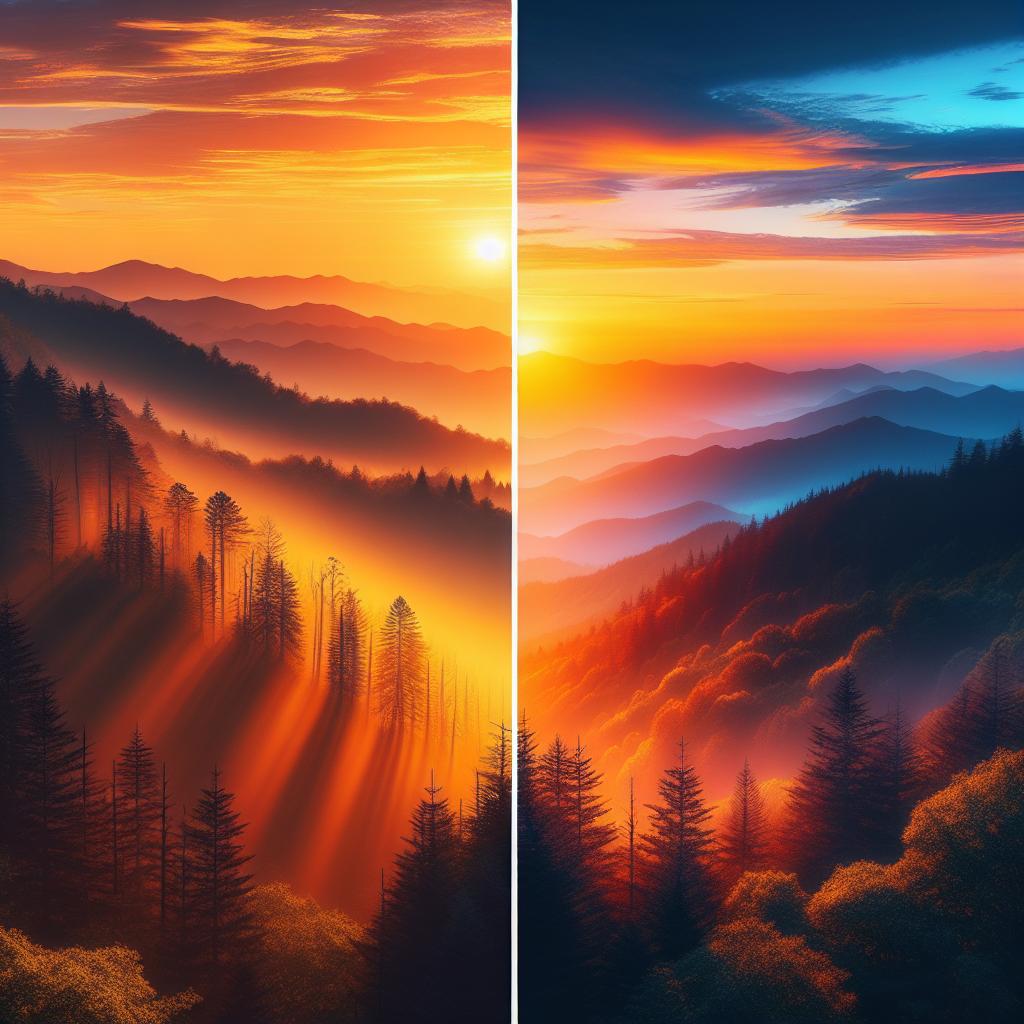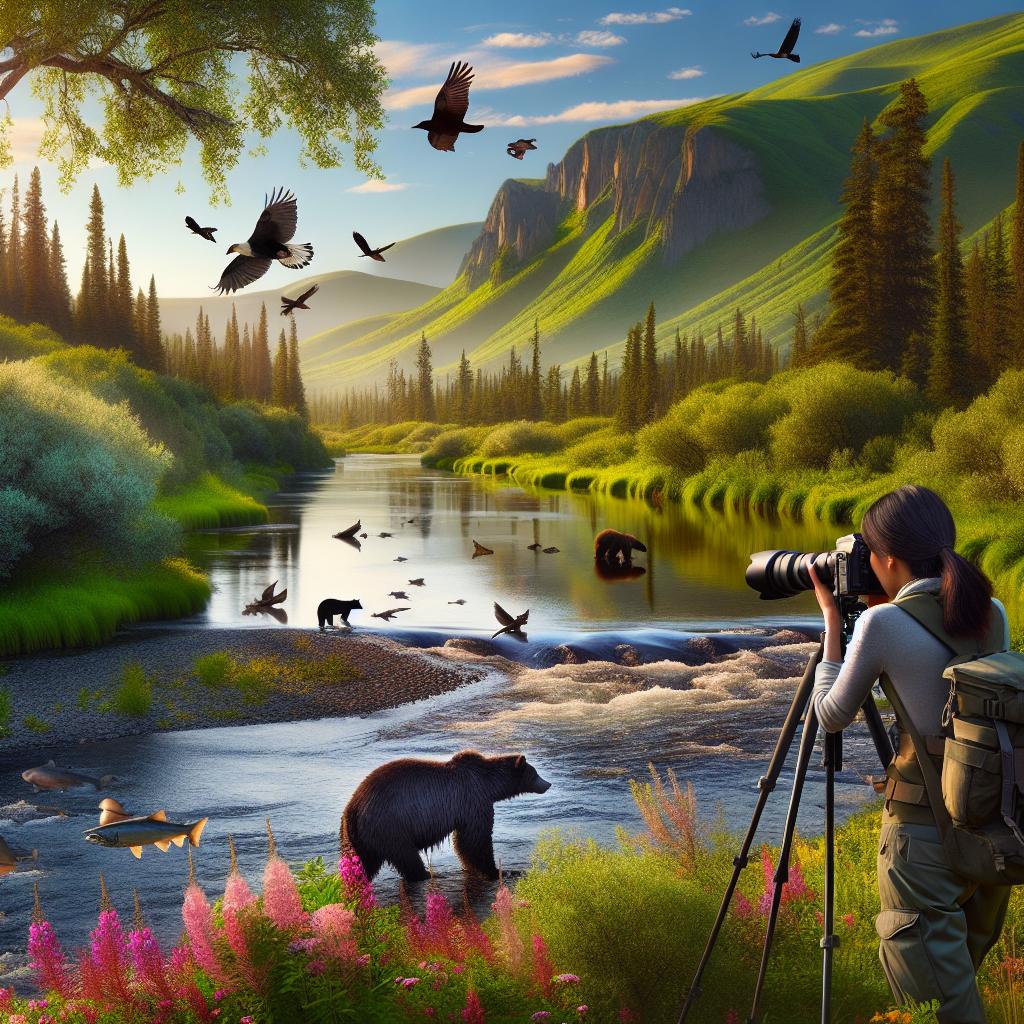Nestled along the border of North Carolina and Tennessee, the Great Smoky Mountains offer an unparalleled canvas for outdoor photography. Their misty peaks and verdant valleys present an ever-changing tableau, where light and shadow dance through ancient forests and across wildflower-laden meadows. With each twist and turn of the hiking trails, a new vista unfurls, begging to be captured through the lens of a camera. Whether you’re a seasoned photographer or an enthusiastic amateur, this guide will equip you with essential tips to make the most of your photographic journey through one of the most biodiverse regions in the world. As we lace up our hiking boots and delve into this enchanting landscape, let’s explore the techniques and insights that will help you immortalize the Smokies’ ethereal beauty.
Perfecting the Golden Hour: Capturing Sunrise and Sunset in the Smokies
As the first light of dawn touches the ridges and valleys of the Smokies, there’s a magic that can’t be captured anywhere else. The **Golden Hour**—that precious time shortly after sunrise and before sunset—offers the most enchanting light for photography. The key to perfecting this moment starts with planning, patience, and precise timing. Here are some pro tips to help you capture the ethereal beauty of the Smoky Mountains during these fleeting moments:
- Location, Location, Location: Scout your spot ahead of time. The Smokies’ landscape offers a myriad of stunning vantage points, but popular ones include Clingmans Dome, Morton Overlook, and Newfound Gap.
- Weather Watch: Keep an eye on the forecast. A mix of clouds can add texture and drama to your photos, while clear skies can highlight the rich colors of the sunrise and sunset.
- Gear Prep: Take the essentials: a sturdy tripod, a wide-angle lens, and a polarizing filter to manage glare and enrich colors.
Consider the atmospheric conditions and how they influence the scene. Mist in the valleys can create a mystical effect, while the interplay of light and shadow in the mountains adds depth and dimension to your shots. Timing is everything; aim to arrive well before the Golden Hour to set up and experiment with angles and compositions.
| Element | Best Practice |
|---|---|
| Sunrise Timing | Arrive at least 30-45 minutes before dawn |
| Sunset Timing | Stay 30 minutes after the sun dips below the horizon |
| Camera Settings | Aperture: f/8 to f/11, ISO: 100-400, Shutter Speed: varies |

Mastering Landscape Shots: Utilizing Natural Light and Terrain
Mastering landscape shots in the Smoky Mountains requires a harmonious blend of natural light and terrain. The best times to capture the magic of these trails are during the golden hours—**just after sunrise** and **right before sunset**. During these periods, the light is soft, diffused, and ethereal, casting long and enchanting shadows that add depth and dimension to your photos. To maximize this, explore hiking trails like the Alum Cave Trail or the Clingmans Dome, where elevated viewpoints allow you to capture the expansive vistas bathed in the golden hue of morning or evening light.
Understanding the terrain of the Smoky Mountains is crucial for capturing stunning images. The varied landscapes—from dense, misty forests to rugged mountaintops—provide fertile ground for creativity.
- Props like fallen logs and meandering streams: highlight the intricate detail and texture.
- Valleys and ridges: perfect for showcasing the scale and grandeur of the mountains.
- Framing techniques: use tree branches or stones to add natural borders to your photos.
Using these elements not only organizes your composition but also draws viewers into an immersive experience. Remember to experiment with different angles and perspectives to truly show off the majestic beauty of the Smoky Mountains.
Gear Essentials: Must-Have Equipment for Trail Photography
When venturing into the Smoky Mountains for some trail photography, having the right gear can make all the difference in capturing jaw-dropping landscapes and wildlife moments. **A reliable DSLR or mirrorless camera** should top your list, ensuring you’re prepared to capture high-resolution images. **Wide-angle and telephoto lenses** are also must-haves; the former for breathtaking panoramic vistas, and the latter for zooming in on distant wildlife. Don’t forget your **sturdy tripod** to keep your shots steady, especially in low-light conditions during dawn or dusk.
- Camera Backpack
- Multiple Memory Cards
- Extra Batteries
- Waterproof Camera Cover
| Gear Item | Purpose |
|---|---|
| Polarizing Filter | Enhance Sky and Water Shots |
| Portable Flash | Fill Light for Shadows |
| Remote Shutter Release | Avoid Camera Shake |
In addition to camera-specific gear, general hiking essentials that double as photography aids are crucial. A **comfortable and durable camera backpack** allows you to carry your equipment hands-free. Ensure there are sections for extra **memory cards and batteries**—you don’t want to run out of either while on the trail. For weather changes, pack a **waterproof camera cover** to protect your gear from unexpected downpours, and bring along a small **portable flash** to manage difficult lighting situations under the thick forest canopy. These little extras can turn a good outing into a spectacular one.

Wildlife Wonders: Ethically Photographing Flora and Fauna
The Smoky Mountains are home to a spectacular array of flora and fauna, making ethical photography essential to preserving this beautiful ecosystem. Respecting wildlife and their habitats is crucial. When in the Smokies, remember to maintain a safe distance from animals and avoid disturbing their routines. Use **long telephoto lenses** to get close-up shots without encroaching on their space. Also, consider the lighting conditions—morning and evening light can bring out the best hues in both plants and animals.
As for the lush flora, tread lightly and stick to marked trails to avoid damaging delicate plant life. Incorporate these strategies to capture the breathtaking diversity found in the region:
- **Macro Photography:** Perfect for detailed shots of wildflowers and insects.
- **Wide-Angle Lenses:** Ideal for capturing expansive forest landscapes.
- **Polarizing Filters:** Help reduce glare and enhance colors in your photos.
To plan your photography excursions, here’s a quick reference table of useful gear for different types of shots:
| Photography Type | Suggested Gear |
|---|---|
| Wildlife | Telephoto Lens, Tripod |
| Flora | Macro Lens, Reflector |
| Landscapes | Wide-Angle Lens, Polarizing Filter |
Q&A
Q&A: Outdoor Photography Tips for Hiking Trails in the Smoky Mountains
Q1: What makes the Smoky Mountains an exceptional spot for outdoor photography?
A1: The Smoky Mountains offer a diverse range of natural beauty, from mist-covered peaks and dense forests to vibrant wildflowers and flowing streams. The interplay of light and shadow in this rugged terrain creates captivating compositions that can be both dramatic and serene, making it a paradise for outdoor photographers.
Q2: What is the best time of day for capturing stunning photographs in the Smoky Mountains?
A2: Early morning and late afternoon are golden hours for photography. The soft, diffused light during these times enhances colors and textures without the harsh shadows cast by midday sun. Morning mist can add an ethereal quality to your landscapes, while late afternoon light brings out the rich hues of the foliage.
Q3: How do I prepare my camera gear for a hiking adventure in the Smoky Mountains?
A3: Preparation is key. Ensure your camera batteries are fully charged and carry spares. Use a sturdy but lightweight tripod for stability on uneven terrain. Protect your gear with weatherproof covers, and pack lens-cleaning tools since the environment can be harsh on your equipment. Also, consider carrying multiple lenses to capture different perspectives—from wide-angle landscapes to intimate macro shots.
Q4: What techniques can help me capture the essence of a trail’s unique character?
A4: To capture the essence of a trail, focus on the details that make it unique. Look for leading lines, such as winding paths or flowing streams, to guide viewers into your photo. Incorporate human elements, like hikers or rustic signs, to convey a sense of scale and adventure. Experiment with different angles and perspectives—sometimes getting low to the ground or finding a higher vantage point can reveal a fresh viewpoint.
Q5: How can I make the most of the Smoky Mountains’ changing weather conditions?
A5: Embrace the weather! Overcast skies can provide soft, even lighting perfect for shooting waterfalls and forests. Mist and fog add layers of mystery and depth to your images. Rain enhances colors and brings out details in foliage and rocks. Just make sure to protect your gear and dress appropriately for the conditions.
Q6: Are there any lesser-known trails in the Smoky Mountains that offer extraordinary photo opportunities?
A6: Absolutely! While popular trails like Clingmans Dome and Alum Cave Bluffs offer breathtaking views, lesser-known trails such as the Porter’s Creek Trail and Gregory Ridge Trail also boast incredible scenery. These trails often have fewer visitors, providing a more intimate experience with nature and fewer distractions when framing your shot.
Q7: What are some post-processing tips for enhancing outdoor photos taken in the Smoky Mountains?
A7: Post-processing can enhance the natural beauty captured in your photographs. Adjust the exposure, contrast, and saturation to bring out the vividness of the landscape. Use tools to highlight textures in the wood and leaves while softening the sky for a balanced look. Experiment with filters to emphasize different moods, and consider cropping to improve composition and focus on the most compelling elements of your shot.
Q8: Can you share any safety tips for photographers hiking in the Smoky Mountains?
A8: Safety is paramount. Always let someone know your itinerary and estimated return time. Stay on marked trails to avoid getting lost and protect the environment. Carry a map, compass, and plenty of water. Be mindful of wildlife, keeping a safe distance especially from bears. Wear sturdy hiking boots for rough terrain and dress in layers to accommodate changing weather.
Q9: How can I interact respectfully with the natural environment while capturing photos?
A9: Respecting nature is crucial. Follow Leave No Trace principles by not disturbing wildlife, taking only pictures, and leaving only footprints. Avoid damaging plants and trees by staying on designated trails. Refrain from using drones in protected areas, as they can disrupt the natural habitat. Capturing the beauty of the Smoky Mountains responsibly ensures that it remains pristine for future photographers.
Wrapping Up
As you lace up your boots and prepare to embark on your next hiking adventure through the enchanting Smoky Mountains, remember that the beauty of nature is just waiting to be captured through your lens. With these outdoor photography tips now in your toolkit, may each step you take reveal a new angle, a hidden gem, and a story woven by the ancient hills and whispering woods.
The Smokies are more than a destination; they are an ever-evolving canvas that invites you to explore, discover, and share your unique perspective. So, let your spirit of adventure guide you, your camera be your faithful companion, and your creativity flow as freely as the mountain streams. Happy hiking and happy snapping!
Until next time, may your trails be scenic and your photo gallery brimming with the essence of the Smoky Mountains.

